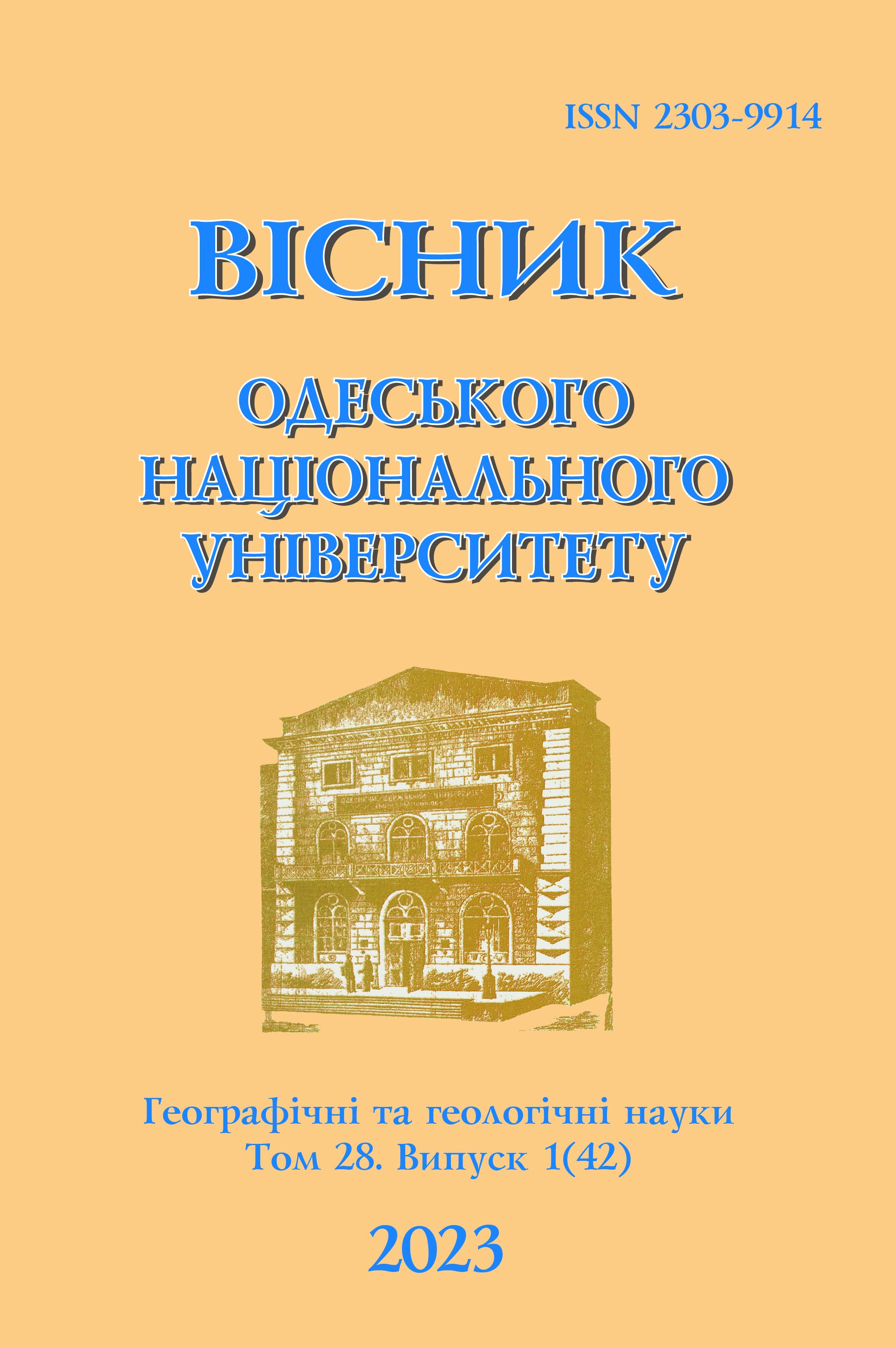ФОРМУВАННЯ АНОМАЛІЙ ТЕМПЕРАТУРИ ПОВЕРХНІ МЕКСИКАНСЬКОЇ ЗАТОКИ ПІД ВПЛИВОМ УРАГАНУ САЛЛІ 11–17 ВЕРЕСНЯ 2020 РОКУ
DOI:
https://doi.org/10.18524/2303-9914.2023.1(42).282234Ключові слова:
аномалії температури води, урагани, взаємодія океану та атмосфери, екманівське накачування, апвелінгАнотація
Формування та інтенсивність тропічних циклонів (ТЦ) залежить від термічного стану вод на поверхні океану. В той же час, динамічні ефекти, що виникають в поверхневому шарі океану внаслідок проходження ТЦ, призводять до зворотних процесів. В роботі приведені результати аналізу просторово-часового розподілу добових аномалій температури поверхні Мексиканської затоки, які формувалися в період проходження над акваторією затоки ТЦ Саллі 11–17 вересня 2020 року.
Посилання
Doronin, Yu. P. (1981). Vzaimodeystvie atmosfery i okeana [Interaction of the atmosphere and the ocean]. Leningrad: Gidrometeoizdat. [in Russian].
El Hadri, Y., Berlinsky, M. A., Volkov, D. Y., & Slizhe, M. O. (2021). Minlyvist' termokhalynnoho rezhymu vod Meksykans'koi zatoky u 2005–2017 rokakh [Variability of thermohaline regime of see water of the Gulf of Mexico in 2005–2017]. Ukrainian hydrometeorological journal, 28, 65–76. https://doi.org/10.31481/uhmj.28.2021.06 [in Ukrainian].
Kagan, B. A. (1992). Vzaimodeystvie atmosfery i okeana [Interaction of the atmosphere and the ocean]. St. Petersburg: Gidrometeoizdat. [in Russian].
Kraus, E. B. (1976). Vzaimodeystvie atmosfery i okeana [Interaction of the atmosphere and the ocean]. Leningrad: Gidrometeoizdat. [in Russian].
Babin, S. M., Carton, J. A., Dickey, T. D., & Wiggert, J. D. (2004). Satellite evidence of hurricane induced phytoplankton blooms in an oceanic desert. Journal of Geophysical Research, 109, C03043. https://doi.org/10.1029/2003JC001938
Chenxu, Ji., Yuanzhi, Z., Qiuming, C., & Jin Yeu Tsou. (2021). Investigating ocean surface responses to typhoons using reconstructed satellite data. International Journal of Applied Earth Observation and Geoinformation, 103. https://doi.org/10.1016/j.jag.2021.102474
Goldenberg, S. B., Landsea, C. W., Mestas- Nunez, A. M., & Gray, W. M. (2001).The recent increase in Atlantic hurricane activity: causes and implications. Science, 293, 474–479.
Knaff, J. A., DeMaria, M., Sampson, C. R., Peak, J. E., Cummings, J., & Schubert, W. H. (2013). Upper Oceanic Energy Response to Tropical Cyclone Passage. Journal of Climate, 26(8), 2631–2650. https://doi.org/10.1175/JCLI-D-12–00038.1
Kossin, J. P., & Vimont, D. J. (2007). A more general framework for understanding Atlantic hurricane variability and trend. Bull. Am. Meteorol. Soc, 88, 1767–1781.
Lin, S., Zhang, W. Z., Shang, S. P., & Hong, H. S. (2017). Ocean response to typhoons in the western North Pacific: Composite results from Argo data. Deep‐Sea Research Part I, 123, 62–74. https://doi.org/10.1016/j.dsr.2017.03.007
Liu, F., & Tang, S. (2018). Influence of the interaction between typhoons and oceanic mesoscale eddies on phytoplankton blooms. Journal of Geophysical Research: Oceans, 123, 2785–2794. https://doi.org/10.1029/2017JC013225
Mooers, C. N. K., & Maul, G. A. (1998). Intra-Americas sea circulation. In Robinson A. R., & Brink K. H. (Eds.), The sea: The global coastal ocean. Regional studies and syntheses (pp. 183–208). New York: John Wiley and Sons.
Muller-Karger, F. E., Smith, J. P., Werner, S., Chen, R. et al. (2015). Natural variability of surface oceanographic conditions in the offshore Gulf of Mexico. Progress in Oceanography, 134, 54–76. https://doi.org/10.1016/j.pocean.2014.12.007
National Hurricane Center. Retrieved November 10, 2022, from https://www.nhc.noaa.gov/
Physical Sciences Laboratory. Retrieved November 10, 2022, from https://psl.noaa.gov/data/gridded/data.noaa.oisst.v2.highres.html
Sanford, T. B., Price, J. F., & Girton, J. B. (2011). Upper ocean response to Hurricane Frances (2004) observed by profiling EM‐APEX floats. Journal of Physical Oceanography, 41(6), 1041–1056. https://doi.org/10.1175/2010JPO4313.1
Shibano, R. S., Yamanaka, Y., Okada, N., Chuda, T., Suzuki, S., & Niino, H. (2011). Responses of marine ecosystem to typhoon passages in the western subtropical North Pacific. Geophysical Research Letters, 38, L18608. https://doi.org/10.1029/2011GL048717
Sturges, W., & Leben, R. R. (2000). Frequency of ring separations for the loop current in the Gulf of Mexico. Journal of Physical Oceanography, 30, 1814–1819.
Sturges, W., & Lugo- Fernandez, A. (2005). Circulation in the Gulf of Mexico: over most of the Gulf observations and models. Washington: AGU.
The National Hurricane Center's Tropical Cyclone Reports. Retrieved November 10, 2022, from https://www.nhc.noaa.gov/data/tcr/AL192020_Sally.pdf
Vimont, D. J., & Kossin, J. P. (2007). The Atlantic meridional mode and hurricane activity. Geophys. Res. Lett, 34, L07709. https://doi.org/10.1029/2007GL029683
Wang, Y. (2020). Composite of typhoon induced sea surface temperature and chlorophyll‐a responses in the South China Sea. Journal of Geophysical Research: Oceans, 125, e2020JC016243. https://doi.org/10.1029/2020JC016243
Ye, H. J., Sui, Y., Tang, D. L., & Afanasyev, Y. D. (2013). A subsurface chlorophyll a bloom induced by typhoon in the South China Sea. Journal of Marine Systems, 128, 138–145. https://doi.org/10.1016/j.jmarsys.2013.04.010
Zavala-Hidalgo, J., Gallegos-García, A., Martínez-López, B. et al. (2006). Seasonal upwelling on the Western and Southern Shelves of the Gulf of Mexico. Ocean Dynamics, 56, 333–338. https://doi.org/10.1007/s10236-006-0072-3
##submission.downloads##
Опубліковано
Як цитувати
Номер
Розділ
Ліцензія

Ця робота ліцензується відповідно до Creative Commons Attribution-NonCommercial 4.0 International License.
Авторські права охороняються Законом України “Про авторське право і суміжні права”.
Автор зобов’язаний подавати свої матеріали у вигляді, що відповідає вимогам відповідних стандартів з підготовки авторських оригіналів та правил, установлених редакцією.
У разі відмови автору в публікації його матеріалів він має право на одержання висновку щодо цього.
Редакційна колегія залишає за собою право на редакційні виправлення.
Гонорар за опубліковані роботи авторам не сплачується, друкований примірник не видається.
Правовласниками опублікованого матеріалу являються авторський колектив та засновник журналу на умовах, що визначаються видавничою угодою, що укладається між редакційною колегією та авторами публікацій. Ніяка частина опублікованого матеріалу не може бути відтворена без попереднього повідомлення та дозволу автора.
Публікація праць в Віснику здійснюється на некомерційній основі.
Усі права на матеріали, опубліковані в Журналі, захищені. Будь-яке використання матеріалів, опублікованих в Журналі повністю або частково, без дозволу Видавництва забороняється. Запити відносно усіх видів використання вказаних матеріалів повинні спрямовуватися у Видавництво.
Автор (співавтори) несуть усю відповідальність за науковий зміст, достовірність відомостей, використовуваних в статті, а також за збереження державної і комерційної таємниці.
Відхилені редколегією статті авторам не повертаються. Рецензент і члени редколегії журналу не мають права використовувати матеріали статті без письмового дозволу автора.


